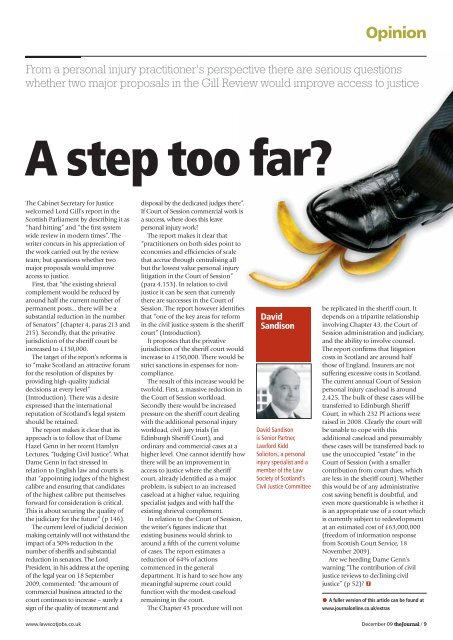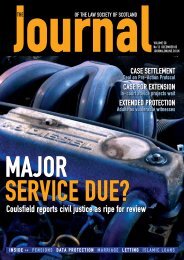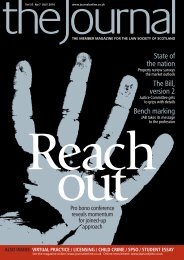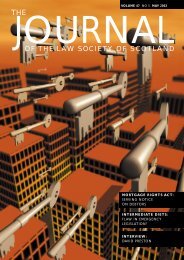Professional briefing - The Journal Online
Professional briefing - The Journal Online
Professional briefing - The Journal Online
You also want an ePaper? Increase the reach of your titles
YUMPU automatically turns print PDFs into web optimized ePapers that Google loves.
<strong>The</strong> Cabinet Secretary for Justice<br />
welcomed Lord Gill’s report in the<br />
Scottish Parliament by describing it as<br />
“hard hitting” and “the first system<br />
wide review in modern times”. <strong>The</strong><br />
writer concurs in his appreciation of<br />
the work carried out by the review<br />
team; but questions whether two<br />
major proposals would improve<br />
access to justice.<br />
First, that “the existing shrieval<br />
complement would be reduced by<br />
around half the current number of<br />
permanent posts... there will be a<br />
substantial reduction in the number<br />
of Senators” (chapter 4, paras 213 and<br />
215). Secondly, that the privative<br />
jurisdiction of the sheriff court be<br />
increased to £150,000.<br />
<strong>The</strong> target of the report’s reforms is<br />
to “make Scotland an attractive forum<br />
for the resolution of disputes by<br />
providing high-quality judicial<br />
decisions at every level”<br />
(Introduction). <strong>The</strong>re was a desire<br />
expressed that the international<br />
reputation of Scotland’s legal system<br />
should be retained.<br />
<strong>The</strong> report makes it clear that its<br />
approach is to follow that of Dame<br />
Hazel Genn in her recent Hamlyn<br />
Lectures, “Judging Civil Justice”. What<br />
Dame Genn in fact stressed in<br />
relation to English law and courts is<br />
that “appointing judges of the highest<br />
calibre and ensuring that candidates<br />
of the highest calibre put themselves<br />
forward for consideration is critical.<br />
This is about securing the quality of<br />
the judiciary for the future” (p 146).<br />
<strong>The</strong> current level of judicial decision<br />
making certainly will not withstand the<br />
impact of a 50% reduction in the<br />
number of sheriffs and substantial<br />
reduction in senators. <strong>The</strong> Lord<br />
President, in his address at the opening<br />
of the legal year on 18 September<br />
2009, commented: “the amount of<br />
commercial business attracted to the<br />
court continues to increase – surely a<br />
sign of the quality of treatment and<br />
disposal by the dedicated judges there”.<br />
If Court of Session commercial work is<br />
a success, where does this leave<br />
personal injury work?<br />
<strong>The</strong> report makes it clear that<br />
“practitioners on both sides point to<br />
economies and efficiencies of scale<br />
that accrue through centralising all<br />
but the lowest value personal injury<br />
litigation in the Court of Session”<br />
(para 4.153). In relation to civil<br />
justice it can be seen that currently<br />
there are successes in the Court of<br />
Session. <strong>The</strong> report however identifies<br />
that “one of the key areas for reform<br />
in the civil justice system is the sheriff<br />
court” (Introduction).<br />
It proposes that the privative<br />
jurisdiction of the sheriff court would<br />
increase to £150,000. <strong>The</strong>re would be<br />
strict sanctions in expenses for noncompliance.<br />
<strong>The</strong> result of this increase would be<br />
twofold. First, a massive reduction in<br />
the Court of Session workload.<br />
Secondly there would be increased<br />
pressure on the sheriff court dealing<br />
with the additional personal injury<br />
workload, civil jury trials (in<br />
Edinburgh Sheriff Court), and<br />
ordinary and commercial cases at a<br />
higher level. One cannot identify how<br />
there will be an improvement in<br />
access to justice where the sheriff<br />
court, already identified as a major<br />
problem, is subject to an increased<br />
caseload at a higher value, requiring<br />
specialist judges and with half the<br />
existing shrieval complement.<br />
In relation to the Court of Session,<br />
the writer’s figures indicate that<br />
existing business would shrink to<br />
around a fifth of the current volume<br />
of cases. <strong>The</strong> report estimates a<br />
reduction of 64% of actions<br />
commenced in the general<br />
department. It is hard to see how any<br />
meaningful supreme court could<br />
function with the modest caseload<br />
remaining in the court.<br />
<strong>The</strong> Chapter 43 procedure will not<br />
Opinion<br />
From a personal injury practitioner’s perspective there are serious questions<br />
whether two major proposals in the Gill Review would improve access to justice<br />
A step too far?<br />
www.lawscotjobs.co.uk<br />
David<br />
Sandison<br />
David Sandison<br />
is Senior Partner,<br />
Lawford Kidd<br />
Solicitors, a personal<br />
injury specialist and a<br />
member of the Law<br />
Society of Scotland’s<br />
Civil Justice Committee<br />
be replicated in the sheriff court. It<br />
depends on a tripartite relationship<br />
involving Chapter 43, the Court of<br />
Session administration and judiciary,<br />
and the ability to involve counsel.<br />
<strong>The</strong> report confirms that litigation<br />
costs in Scotland are around half<br />
those of England. Insurers are not<br />
suffering excessive costs in Scotland.<br />
<strong>The</strong> current annual Court of Session<br />
personal injury caseload is around<br />
2,425. <strong>The</strong> bulk of these cases will be<br />
transferred to Edinburgh Sheriff<br />
Court, in which 232 PI actions were<br />
raised in 2008. Clearly the court will<br />
be unable to cope with this<br />
additional caseload and presumably<br />
these cases will be transferred back to<br />
use the unoccupied “estate” in the<br />
Court of Session (with a smaller<br />
contribution from court dues, which<br />
are less in the sheriff court). Whether<br />
this would be of any administrative<br />
cost saving benefit is doubtful, and<br />
even more questionable is whether it<br />
is an appropriate use of a court which<br />
is currently subject to redevelopment<br />
at an estimated cost of £63,000,000<br />
(freedom of information response<br />
from Scottish Court Service, 18<br />
November 2009).<br />
Are we heeding Dame Genn’s<br />
warning “<strong>The</strong> contribution of civil<br />
justice reviews to declining civil<br />
justice” (p 52)?<br />
A fuller version of this article can be found at<br />
www.journalonline.co.uk/extras<br />
December 09 the<strong>Journal</strong> / 9










